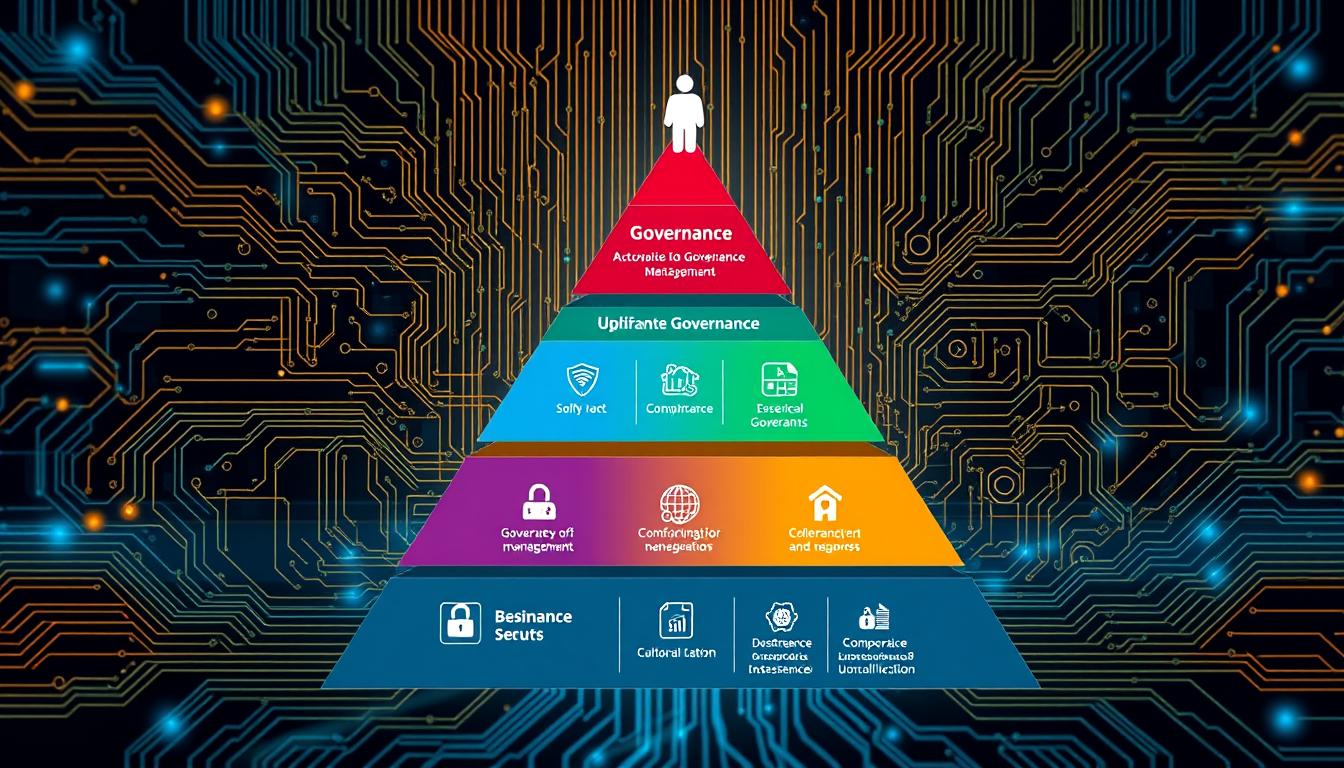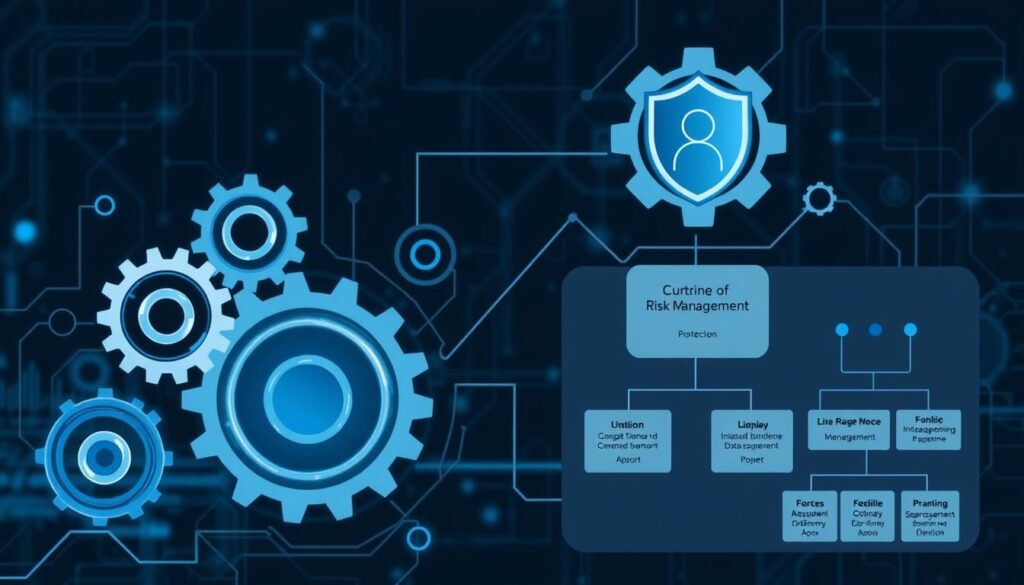
Did you know only 39.6% of security leaders meet with their boards monthly to talk about security? This shows how important good governance is in today’s cyber world. Companies need to check their security level often to stay safe. Not doing so can lead to big problems.
Having good security plans is not enough. You must always check and improve your security to keep data safe. This is key to protecting your sensitive information.
A strong information security governance model can guide you through cybersecurity challenges. It helps avoid breaches and keeps your company in line with important rules like the NIST Cybersecurity Framework. This article will show you how to check your company’s security level and make it better.
Understanding Information Security Governance Maturity
Information security governance is about managing and protecting your organization’s information. It includes risk management and following regulations. Governance maturity shows how well these practices are working. Knowing this helps organizations see where they need to improve.
Defining Information Security Governance
Information security governance is about managing information well. It means having a plan to handle risks and clear policies. It’s about balancing people, policy, process, and technology to improve governance.
Many organizations have different levels of maturity in these areas. This shows where they need to get better.
The Importance of Governance Maturity
Governance maturity is very important. Organizations with good governance are better at fighting off security threats. About 70% of organizations struggle to set up good information governance.
Good governance helps you check your progress against industry standards. It also makes sure you follow the rules. Without a solid plan, organizations often don’t know their data well.
What is the Information Security Governance Maturity Model?
The information security governance maturity model is a key tool for companies. It helps them check their security level and set goals for better security. Knowing where your company stands lets you plan better security strategies.
Maturity models have levels from simple to complex. This makes it easier to compare different companies’ security levels.
Overview of Maturity Models
Maturity models offer clear paths for checking capabilities. They have five levels, each showing a different stage of security:
- Ad hoc governance: Seen in new companies, this level has no set security rules, leading to uneven security.
- Establishing basic structures and processes: First steps in security start, often because of rules or big security issues.
- Going beyond the basics: Companies start linking security with business plans, improving how they talk about security and get people involved.
- Extending and maturing: At this stage, security is a big part of how the company works, making sure security is thought of in all plans.
- Achieving embedded and influential governance: Here, security is a big part of the company’s overall plan, helping manage risks well.
Levels of Maturity in Information Security Governance
Knowing your company’s maturity level is key for a good security plan. Each level shows different skills and focuses in security. Moving up these levels means a company does more than just follow rules and gets better at fighting cyber threats.
Good governance makes a company stronger against cyber threats and helps it succeed in the long run. Understanding the maturity model helps you make plans that fit changing security needs.
Benefits of Assessing Your Information Security Governance Maturity
Checking your information security governance maturity has big benefits. It’s not just about following rules. It helps fix big security problems and makes your whole organization safer.
Reducing Security Breaches
Cybersecurity is super important today, with attacks happening every 39 seconds. Companies that check their security can cut down on breaches. They might see a 50% drop in security problems if they do risk checks often.
Good governance also spots and fixes security holes. Most security issues come from people making mistakes, not technology. So, teaching employees and managing risks is key to keeping your data safe.
Enhancing Compliance with Regulations
Keeping data safe is a big deal, even more so when you’re changing to digital. Rules like PCI, HIPAA, GDPR, and ISO 27001 keep getting stricter. Companies need to update their security plans to stay in line.
Using strong security frameworks can make you 40% more likely to follow the rules. Regular checks are important, too. They help avoid big fines and protect your company’s image. Leaders playing a role is also vital, as 92% of companies say they need board support for good governance.
Key Components of Information Security Governance
Effective information security governance has several key parts. These parts help make a strong framework. They make sure organizations can handle security challenges and keep getting better.
Risk Management Strategies
Good risk management is at the heart of security. Regular checks help spot weak points and strong areas. This lets companies act fast to fix problems before they get worse.
Companies that focus on risk management get better at security. They can deal with the growing number of threats.
Effective Security Policies and Procedures
Having good security policies is very important. They set clear rules and guidelines for everyone. This helps create a culture where security is a big deal.
When employees know the rules, they help keep the company safe. This lowers the chance of security breaches. It also makes the company’s cybersecurity efforts more disciplined.
Leadership and Organizational Culture
Leaders are key in building a strong security culture. When leaders show they care about security, everyone gets on board. This makes the company better at handling risks and following new rules.

Frameworks Supporting Information Security Governance Maturity
Many established frameworks help organizations improve their information security governance. They offer structured ways to align security with business goals. This ensures a strong risk management strategy.
NIST Cybersecurity Framework
The NIST Cybersecurity Framework is a detailed guide for all types of organizations. It focuses on managing cybersecurity risks through an integrated, risk-based approach. It has five main functions:
- Identify: Understand the organization’s environment to manage cybersecurity risk.
- Protect: Implement safeguards to ensure the delivery of critical services.
- Detect: Develop appropriate activities to identify the occurrence of a cybersecurity event.
- Respond: Take action regarding a detected cybersecurity event.
- Recover: Maintain plans for resilience and restore any capabilities or services impaired due to a cybersecurity event.
COBIT for IT Governance
COBIT is all about IT governance, helping organizations align IT security with business goals. It has five main categories:
| Category | Description |
|---|---|
| Plan & Organize | Establish the IT governance strategy. |
| Acquire & Implement | Acquire necessary resources and implement processes. |
| Deliver & Support | Deliver services and support the organization’s operations. |
| Monitor & Evaluate | Monitor performance and evaluate processes for improvement. |
| Manage & Assess | Continuously manage and assess the IT environment. |
The NIST Cybersecurity Framework and COBIT both highlight the importance of risk management. They focus on identifying, assessing, and monitoring risks. This is key for accountability and following regulations. Using these frameworks helps raise awareness about risk management among stakeholders.
Steps to Assess Your Information Security Governance Maturity
Evaluating your information security governance maturity needs a clear plan. This helps you understand your current state and plan for betterment. The first step is a self-assessment, which shows what you’re doing right and what needs work.
Conducting a Self-Assessment
A detailed self-assessment lets you compare your security with industry standards. It finds big gaps, with about 70% of companies spotting major issues. This process can take 4 to 12 weeks, depending on your organization’s size and complexity.
This process not only shows your strengths but also points out weaknesses. For example, only 30% of companies have a tested incident response plan. Knowing these weaknesses helps you focus on improving risk management.
Utilizing Assessment Tools
Using established tools is key for a thorough check. The NIST’s PRISMA review is a good way to measure your level. These assessment tools help you keep standards and check your progress.
Regular checks help improve your security culture. This proactive step helps you keep up with cybersecurity changes. It shows your progress to leaders. Companies using a common framework see a 30% better security posture.
With the right tools, you can make plans to improve your security. This can boost your risk management by about 60%.
| Assessment Type | Duration | Common Findings | Actionable Outcomes |
|---|---|---|---|
| Self-Assessment | 4 to 12 Weeks | 70% identify security gaps | Develop risk management strategies |
| NIST PRISMA Review | 60 to 90 Days | 30% have documented response plans | Establish a documented response plan |
| Continuous Assessment | Ongoing | 50% reduction in incident impact | Enhance incident response capabilities |
Using a structured method for self-assessment and tools is key. It helps improve your information security governance. This way, you can better defend against threats.
Enhancing Your Information Security Governance Maturity
Creating a strong information security governance framework needs constant effort and proactive steps. By following governance best practices, companies can boost their cybersecurity. A structured plan helps tackle vulnerabilities and promotes a security-aware culture among employees.
Implementing Best Practices for Governance
To boost your information security governance, adopt key best practices. Regular training keeps employees up-to-date on threats and prevention methods. Keeping documentation current is also key for consistency in your organization.
Setting up proactive risk management can greatly reduce risks. Studies show companies with thorough management see a 50% drop in incidents.
Continuous Monitoring and Improvement
Continuous monitoring is key to keeping your governance framework strong. It lets your organization quickly respond to new threats. This approach helps detect issues faster, allowing for a 70% quicker response to incidents.
Continuous monitoring also encourages ongoing improvement. As you refine your security, the benefits of your investments will show in 12 to 18 months. This highlights the value of proactive management.
Common Challenges in Improving Governance Maturity
When you aim to boost your organization’s governance maturity, you’ll face many hurdles. These can include internal pushback, the need to follow rules, and keeping up with security needs. It’s key to understand these challenges to move forward.
Overcoming Resistance to Change
Change can be hard for IT staff and management to accept. This can slow down your efforts to improve governance maturity. To overcome this, it’s important to involve everyone and explain the value of new security measures. This approach can help build a culture that supports change and growth.
Balancing Compliance and Business Needs
It’s a constant battle to meet rules while keeping operations flexible. Staying compliant can take a lot of time and resources, which can clash with daily business tasks. To tackle this, it’s essential to weave compliance into your business strategy. This way, security efforts can support, not block, your business goals.

| Challenges | Description | Impact |
|---|---|---|
| Resistance to Change | Opposition from stakeholders when implementing new security initiatives. | Hinders progress and delays improvements in governance maturity. |
| Resource Allocation | Insufficient budget and personnel for cybersecurity initiatives. | Limits the ability to enforce standardized processes and achieve compliance. |
| Compliance Requirements | The necessity to meet evolving regulations without disrupting business operations. | Creates tension between security objectives and business performance. |
| Lack of Alignment | Poor integration between business strategies and governance objectives. | Leads to inefficiencies and resource misallocation. |
Conclusion
Assessing and improving your information security governance is key to a strong cybersecurity. The information security governance maturity model offers a framework. It helps organizations understand their strengths and weaknesses. This way, your organization can better face new threats and improve its cybersecurity readiness.
Many organizations, like those in the hospital sector, face challenges in achieving high maturity levels. Starting with a solid information security program is important. It helps in implementing structured governance practices. This approach improves security awareness and reduces risks from human mistakes.
Regularly checking and updating your governance strategy is important. It ensures you follow laws like HIPAA and ISO 27001. This leads to better security and success in your operations. By focusing on improving your information security governance, your organization can stay safe and achieve its goals.
Source Links
- Security Maturity Models: Levels, Assessment, and Benefits
- How to Build Information Security Maturity: Models + Best Practices Explained
- Cybersecurity Capability Maturity Model (C2M2)
- Understanding maturity models in cybersecurity
- Understanding Data Governance Maturity: An In-Depth Exploration – DATAVERSITY
- Cybersecurity vs. InfoSec Maturity Models
- Achieving the Five Levels of Information Security Governance
- What Is a GRC Maturity Model? Key Indicators & Stages
- Security Maturity: Why You Need It and How to Achieve It
- Unlocking the Benefits of Information Security Governance and Risk Management
- What is a Cybersecurity Maturity Model? | ConnectWise
- Cybersecurity Maturity Model: Your Roadmap to a Stronger Security Posture
- Information Security Governance Framework Guide for IT Activities
- Top 11 cybersecurity frameworks in 2024
- Your Guide to Cybersecurity Maturity Assessments
- Measuring to Level Up: Maturing Your Information Security Program – Vantage Technology Consulting Group
- 5 Steps to Greater Security Maturity with NIST CSF | Verve Industrial
- Guide to Cybersecurity Maturity Model Levels | Evolve Security
- Council Post: The Cybersecurity Maturity Model: A Means To Measure And Improve Your Cybersecurity Program
- Data Governance Maturity Model: Enhancing Your Data Practices
- Cybersecurity Governance, Part 1: 5 Fundamental Challenges
- What are the common challenges and pitfalls of improving IT security maturity?
- What are the common challenges or barriers to improving GRC maturity?
- The development of an information security governance maturity model for Dutch hospitals
- Information security awareness maturity: conceptual and practical aspects in Hungarian organizations



